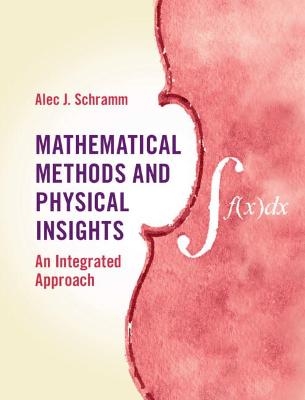
Mathematical Methods and Physical Insights
Cambridge University Press (Verlag)
978-1-107-15641-8 (ISBN)
Mathematics instruction is often more effective when presented in a physical context. Schramm uses this insight to help develop students' physical intuition as he guides them through the mathematical methods required to study upper-level physics. Based on the undergraduate Math Methods course he has taught for many years at Occidental College, the text encourages a symbiosis through which the physics illuminates the math, which in turn informs the physics. Appropriate for both classroom and self-study use, the text begins with a review of useful techniques to ensure students are comfortable with prerequisite material. It then moves on to cover vector fields, analytic functions, linear algebra, function spaces, and differential equations. Written in an informal and engaging style, it also includes short supplementary digressions ('By the Ways') as optional boxes showcasing directions in which the math or physics may be explored further. Extensive problems are included throughout, many taking advantage of Mathematica, to test and deepen comprehension.
Alec J. Schramm is a professor of physics at Occidental College, Los Angeles. In addition to conducting research in nuclear physics, mathematical physics, and particle phenomenology, he teaches at all levels of the undergraduate curriculum, from courses for non-majors through general relativity and relativistic quantum mechanics. After completing his Ph.D., he lectured at Duke University and was a KITP Scholar at the Kavli Institute for Theoretical Physics at UC Santa Barbara. He is regularly nominated for awards for his physics teaching and clear exposition of complex concepts.
Preface; Part I. Things You Just Gotta' Know: 1. Prelude: symbiosis; 2. Coordinating coordinates; 3. Complex numbers; 4. Index algebra; 5. Brandishing binomials; 6. Infinite series; 7. Interlude: orbits in a central potential; 8. Ten integration techniques and tricks; 9. The Dirac delta function; 10. Coda: statistical mechanics; Part II. The Calculus of Vector Fields: 11. Prelude: visualizing vector fields; 12. grad, div & curl; 13. Interlude: irrotational and incompressible; 14. Integrating scalar & vector fields; 15. The theorems of Gauss & Stokes; 16. Simply connected regions; 17. Coda: mostly Maxwell; Part III. Calculus in the Complex Plane: 18. Prelude: path independence in the complex plane; 19. Series, singularities & branches; 20. Interlude: conformal mapping; 21. The calculus of residues; 22. Coda: analyticity & causality; Part IV. Linear Algebra: 23. Prelude: superposition; 24. Vector space; 25. The inner product; 26. Interlude: rotations; 27. The Eigenvalue problem; 28. Coda: normal modes; Entr'acte: Tensors; 29. Cartesian tensors; 30. Beyond cartesian; Part V. Orthogonal Functions: 31. Prelude: 1 2 3 . . . infinity; 32. Eponymous polynomials; 33. Fourier series; 34. Convergence and completeness; 35. Interlude: beyond the straight & narrow; 36. Fourier transforms; 37. Coda: of time intervals and frequency bands; Part VI. Differential Equations: 38. Prelude: first order first; 39. Second-order ODEs; 40. Interlude: the Sturm-Liouville Eigenvalue problem; 41. Partial differential equations; 42. Green's functions; 43. Coda: quantum scattering; Appendix A. Curvilinear coordinates; Appendix B. Rotations in R3; Appendix C. The Bessel family of functions; References; Index.
| Erscheinungsdatum | 16.06.2022 |
|---|---|
| Verlagsort | Cambridge |
| Sprache | englisch |
| Maße | 193 x 253 mm |
| Gewicht | 1820 g |
| Themenwelt | Mathematik / Informatik ► Mathematik ► Angewandte Mathematik |
| Naturwissenschaften ► Physik / Astronomie ► Angewandte Physik | |
| ISBN-10 | 1-107-15641-6 / 1107156416 |
| ISBN-13 | 978-1-107-15641-8 / 9781107156418 |
| Zustand | Neuware |
| Haben Sie eine Frage zum Produkt? |
aus dem Bereich



